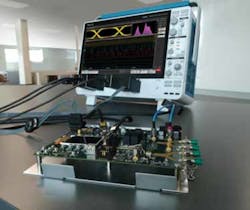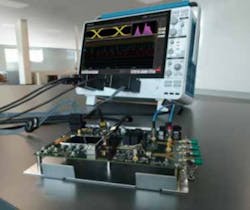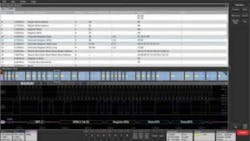Embedded designs present more data, higher speeds
Designers of embedded systems are facing challenges as their everyday measurement needs evolve, according to Mark Briscoe, product marketing manager at Tektronix. They need to contend with more data and higher speeds as video as well as motion, position, and 3D sensing proliferate.
“Designs are getting smarter and incorporating more sensors,” he said during a demonstration of the company’s new 6 Series MSO oscilloscope last summer in Boston. In addition, he said, “Embedded designs are using faster clocks and high-speed serial buses to move and process more data,” requiring high-performance instruments to see the high-speed signals.
And speed isn’t the only issue. So, too, is power, as designers strive to minimize power consumption while delivering clean power to complex ASICs and FPGAs. Power-quality measurements require instruments that can detect small signals in noisy environments. “Hunting down interfering signals is challenging when you can’t see them through the noise,” he said. “New demands just keep coming.”
Briscoe cited DDR3 debug and characterization as a specific example. “DDR3 memory characterization requires acquisition of a system clock and up to 64 data channels,” he said, adding that 1,600-MT/s systems require at least 6.7 GHz of bandwidth to measure accurately. An instrument that provides interleaving, or half-channel sampling, reduces the available channels at full bandwidth.
Similar issues apply to MIPI D-PHY (display and camera) mobile and automotive, low-voltage differential-signaling (LVDS), PCIe Gen 1 and 2 communication, and automotive Ethernet interfaces, he said.
With regard to automotive Ethernet, he said ADAS and human-to-machine subsystems are generating vast amounts of data, while automotive Ethernet employs unshielded twisted-pair cabling to minimize weight and cost while driving data rates to 1,000 Mb/s and employing PAM3 modulation. Automotive Ethernet places strict constraints on signal levels, noise, and clock characteristics, he said, introducing new concepts to engineers used to working with CAN and LIN.
Briscoe also commented on power-semiconductor device challenges, citing faster risetimes, higher frequencies, and higher voltages. Power-semiconductor applications require high bandwidths to capture the fast risetimes. In addition, switching action can result in high common-mode signals that interfere with the measurement of signals across FETs, he said, adding that traditional scope probes may not have sufficient common-mode rejection at high bandwidths. Furthermore, noise can obscure important details in switching waveforms. “Floating differential measurements, such as high-side VGS, are difficult to make,” he summarized.
It’s with such challenging applications in mind that Tektronix in July introduced the 6 Series MSO mixed-signal oscilloscope. The new oscilloscope operates to 8 GHz and delivers a 25-GS/s sample rate simultaneously on its four channels to accommodate the needs of designers working on faster, more complex embedded-systems designs. With a 25-GS/s sample rate on all channels, designers can accurately view up to four high-speed signals at one time. For example, a DDR3 clock and three DDR3 data channels can be viewed and analyzed simultaneously, decreasing the time it takes to fully characterize a design with an instrument that shares sampling systems between channels. “The 6 Series MSO enables viewing multiple data channels at once, accelerating the process significantly,” Briscoe said.
The new 6 Series MSO also offers low-noise inputs especially at the highest sensitivity settings where it matters most, providing measurement confidence on the smallest signals, Briscoe said, adding that this capability comes from the new TEK061 preamplifier ASIC that offers a better than 75% reduction in noise compared with a typical oscilloscope at 1 mV/div.
Briscoe added that the 6 Series incorporates 12-bit ADCs. At 625 MS/s, a high-res mode offers resolution to 16 bits at 200 MHz to let users observe fine details and improve measurement accuracy. “A unique DSP filter limits bandwidth and thus, noise, providing a more accurate view of the signal,” he said.
Briscoe also emphasized the industrial design of the scope, which, at only 7 inches deep and weighing 28 lbs., saves desk space and provides convenience. A new visual trigger lets users define graphical areas in standard rectangle, triangle, trapezoid, and hexagon shapes, or they can define their own custom shapes. With respect to each graphical area, trigger filters include “in,” “out,” or “don’t care,” and users can employ logical expressions on multiple areas to determine trigger conditions.
The 6 Series MSO is based on the same platform as the 5 Series MSO introduced last year and which was the result of a clean-sheet design.1 Features of the 5 Series that carry over to the 6 Series include an intuitive user interface, a capacitive pinch-zoom-swipe 15.6-inch touchscreen, FlexChannel inputs, a 12-bit ADC, a new industrial design, and optional Windows 10 operating system.
Like the 5 Series MSO, the 6 Series MSO is upgradeable and is available with a built-in arbitrary/function generator, DVM, frequency counter, and protocol options. Also, like the 5 Series MSO, adding a TLP058 logic probe turns any of the instrument’s four FlexChannel inputs into eight digital inputs. The 6 Series MSO also has upgradeable bandwidth, starting at 1 GHz and extending up to 8 GHz with a license upgrade.
Since the launch of the 5 Series MSO, Tektronix has added the following capabilities that will be available on both platforms:
- options for decode and trigger support for CAN FD, MIL-STD-1553, ARINC429, and SENT bus;
- options for serial compliance testing for automotive Ethernet and USB 2.0; and
- an advanced power analysis option.
- Tektronix has also launched a series of higher performance probes suited to the performance levels of the 6 Series MSO. The TDP7700 is a series of TriMode probes with bandwidths of 4, 6, or 8 GHz. TriMode probes enable engineers to make the single-ended, differential, and common-mode signal measurements required for high-speed bus analysis, without moving or changing probes. These probes use the TekFlex connector technology, which places active buffers at the probe tip for the best signal fidelity while limiting mechanical stress on tiny test points and supports a variety of connectivity methods to the device under test including solder-in tips, direct connection, and handheld browsing.
- In addition, the TAP4000 and TDP4000 probes extend the range of Tektronix’s active single-ended and differential probes, respectively, and now support up to 4-GHz bandwidth.
SPMI protocol decode
Tektronix also introduced protocol decode, triggering, and analysis support for the MIPI Alliance’s System Power Management Interface (SPMI) for both the 5 and 6 Series MSO scopes. SPMI connects processors in mobile devices to one or more power controllers and enables processors to dynamically increase or decrease power to specific subsystems for reduced power consumption. With Tektronix’s SPMI decode option, users can easily decode bus activity, saving time compared with attempting to decode bus activity manually. Bus sequences are displayed with color-coding indicating sequence starts, master IDs, commands, addresses, data, and acknowledgments.
“As our support for SPMI indicates, we are following through on our commitment to deliver long-term investment protection for both the 5 Series MSO and the new 6 Series MSO,” said Brian Ice, general manager, Mainstream Oscilloscopes at Tektronix, in a press release. “Now, engineers working to reduce the power consumption of mobile devices can speed through debug and analysis tasks with exceptional convenience and confidence.”
The SPMI software option gives users the ability to trigger the scope on specific bus activity and search through acquisitions. Other features include the ability to check bus sequence timing and compare bus activity to embedded software with a time-stamped decode table and to correlate bus activity with precision voltage and current measurements on voltage regulator outputs.
Reference
1. Nelson, Rick, “Tektronix offers new face to midrange oscilloscope,” Rick’s Blog, EE-Evaluation Engineering Online, June 6, 2017.
About the Author

Rick Nelson
Contributing Editor
Rick is currently Contributing Technical Editor. He was Executive Editor for EE in 2011-2018. Previously he served on several publications, including EDN and Vision Systems Design, and has received awards for signed editorials from the American Society of Business Publication Editors. He began as a design engineer at General Electric and Litton Industries and earned a BSEE degree from Penn State.


